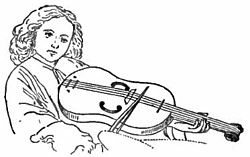Guitar fiddle

Typical Alto Guitar Fiddle, 15th century (Pinakothek, Munich) — from Ruhlmann's Geschichte der Bogeninstrumente (History of bowed instruments)
|
|
| String instrument | |
|---|---|
| Classification | Bowed string instrument |
| Related instruments | |
|
Bowed Plucked |
|
Bowed
Plucked
The Guitar fiddle or Troubadour Fiddle is a modern name bestowed retrospectively upon certain precursors of the violin possessing characteristics of both guitar and fiddle. The name guitar fiddle is intended to emphasize the fact that the instrument in the shape of the guitar, which during the Middle Ages represented the most perfect principle of construction for stringed instruments with necks, adopted at a certain period the use of the bow from instruments of a less perfect type, the rebab and its hybrids.
The use of the bow with the guitar entailed certain constructive changes in the instrument: the large central rose sound hole was replaced by lateral holes of various shapes; the flat bridge, suitable for instruments whose strings were plucked, gave place to the arched bridge required in order to enable the bow to vibrate each string separately; the arched bridge, by raising the strings higher above the sounding board, made the stopping of strings on the neck extremely difficult if not impossible; this matter was adjusted by the addition of a fingerboard of suitable shape and dimensions (fig. 1). At this stage the guitar fiddle possesses the essential features of the violin, and may justly claim to be its immediate predecessor not so much through the viols which were the outcome of the Minnesinger fiddle with sloping shoulders, as through the intermediary of the Italian lyra, a guitar-shaped bowed instrument with from 7 to 12 strings.
From such evidence as we now possess, it would seem that the evolution of the early guitar with a neck from the Greek cithara took place under Greek influence in the Christian East. The various stages of this transition have been definitely established by the remarkable miniatures of the Utrecht Psalter. Two kinds of citharas are shown: the antique rectangular, and the later design with rounded body having at the point where the arms are added indications of the waist or incurvations characteristic of the outline of the Spanish guitar. The first stage in the transition is shown by a cithara or rotta in which arms and transverse bar are replaced by a kind of frame repeating the outline of the body and thus completing the second lobe of the Spanish guitar. The next stages in the transition are concerned with the addition of a neck and of frets. All these instruments are twanged by the fingers. One may conclude that the use of the bow was either unknown at this time (c. 6th century), or that it was still confined to instruments of the rebab type. The earliest known representation of a guitar fiddle complete with bow (fig. 2) occurs in a Greek Psalter written and illuminated in Caesarea by the archpriest Theodore in 1066 (British Library, Add. MS. 19352). Instances of perfect guitar fiddles abound in the 13th century MSS. and monuments, as for instance in a picture by Cimabue (1240–1302), in the Pitti Gallery in Florence.
...
Wikipedia
